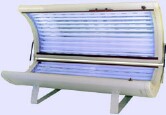- Skip Storing This Everyday Product in the Fridge Door
- Green Tea + B3 Pairing May Boost Brain Health
- Navigating Your Midlife Crisis: Embracing New Possibilities
- City Raccoons Showing Signs of Domestication
- Mapping the Exposome: Science Broadens Focus to Environmental Disease Triggers
- One Week Less on Social Media Linked to Better Mental Health
- Your Brain Changes in Stages as You Age, Study Finds
- Some Suicide Victims Show No Typical Warning Signs, Study Finds
- ByHeart Formula Faces Lawsuits After Babies Sickened With Botulism
- Switch to Vegan Diet Could Cut Your Greenhouse Gas Emissions in Half
Tanning Salons Now Outnumber McDonald’s Outlets in Florida: Study


Skin cancer researchers report in a new study that in the sunny state of Florida, tanning salons now outnumber McDonald’s fast-food restaurants.
There are also more indoor tanning facilities in Florida than CVS pharmacies as well as some other widespread businesses, researchers from the University of Miami revealed.
“Indoor tanning is known to cause skin cancers, including melanoma, which is deadly,” noted one expert, Dr. Joshua Zeichner, of the department of dermatology at The Mount Sinai Hospital in New York City. “Despite an increase in public awareness efforts from dermatologists, people are still sitting in tanning beds,” said Zeichner, who was not connected to the new research.
Researchers led by Dr. Sonia Lamel of the University of Miami found there is now one tanning salon for every 15,113 people in Florida. The study, published Dec. 25 in JAMA Dermatology, also found that the state had about one tanning salon for every 50 square miles.
And although there are 868 McDonald’s fast-food outlets and 693 CVS pharmacies in Florida, the state is also home to many more tanning salons — 1,261 to be exact. Only Bank of America ATMs, which total 1,455 in Florida, outnumbered indoor tanning facilities. Although most of these tanning salons only offered tanning services, the researchers noted that some were found in residential buildings and fitness centers.
The statistics are alarming, the researchers said, because indoor tanning is associated with the development of melanoma and non-melanoma skin cancer. This is particularly true for anyone younger than 35 years old who uses these facilities. Teen girls and young adults commonly use tanning salons, Lamel’s team said. At the same time, Florida has the second highest incidence of melanoma in the United States, according to the authors.
“Hindsight is 20/20, but what we need is foresight to stop indoor tanning and prevent the development of avoidable skin cancers,” said Zeichner, who is director of cosmetic and clinical research at Mount Sinai. “Dermatologists, primary care doctors, pediatricians, and lawmakers must work together to enforce stricter regulations on tanning and educate the public on the risk you put yourself at even after one tanning salon session.”
More information
The U.S. Centers for Disease Control and Prevention provides more information on the health risks associated with indoor tanning.
Source: HealthDay
Copyright © 2025 HealthDay. All rights reserved.










